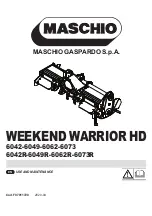
SECTION 3 -- FIELD OPERATION
3--97
DRAWBARS AND TOWING ATTACHMENTS
NOTE:
Before attaching trailed equipment to the
tractor, read the following text carefully.
ATTACHING/DETACHING TRAILED
EQUIPMENT
IMPORTANT:
Regulations in some areas require
brakes on towed equipment when operating on the
public highway. Before travelling on public roads,
make sure you comply with the legal requirements
for your country.
To attach the tractor to trailed equipment and
implements:
1. Ensure that the implement is at draw bar height.
2. Slowly inch rearwards to allow the drawbar and
implement hitch to align.
3. Apply the parking brake and stop the engine.
4. Insert the hitch pin and ensure that the retainer
is in the latched position.
IMPORTANT:
When
attaching
mounted
or
semi-mounted equipment to the 3-point linkage or
when attaching trailed equipment to the drawbar or
hitch, ensure that there is adequate clearance
between
the
implement
and
the
tractor.
Semi-mounted or trailed equipment may interfere
with the tractor rear tyres. If necessary, adjust
steering stops (four wheel drive only) or linkage
stabilisers.
NOTE:
For implements that require hitch extensions
or interfere with the tractor clevis, remove and store
the clevis and hitch pin.
Always use a safety chain installed between the
tractor and implement hitch when transporting
equipment on the highway. See page 3--101.
Observe the following precautions for towing
equipment not equipped with brakes:
•
Do not tow equipment weighing more than twice
the tractor weight.
•
Do not exceed 10 MPH (16 km/h) if towed
equipment weighs more than the tractor.
•
Do not exceed 20 MPH (32 km/h) while towing
equipment that weighs less than the tractor.
DRAWBAR SAFETY
WARNING
Do not pull from the lower links with the links above
the horizontal position. Always use the drawbar,
pick-up hitch or lower links in the lowered position for
pull-type work, otherwise the tractor may overturn
rearwards.
NOTE:
When supporting equipment on the drawbar
ensure that the total weight on the rear axle does not
exceed the maximum static downward load or the
rear tyre load capacity, whichever is the lower (see
Tyre Pressures and Permissible Loads at the end of
Section 3).
IMPORTANT:
When transporting equipment on the
highway it is recommended that a safety chain
having a tensile strength equal to the gross weight of
the implement be installed between the tractor and
implement hitch. See Safety Chain on page 3--101.
Содержание T6010 DELTA
Страница 1: ...OPERATOR S MANUAL T6010 T6020 T6030 T6050 T6070 Delta and Plus Tractors ...
Страница 6: ...BLANK ...
Страница 28: ...SECTION 1 GENERAL INFORMATION AND SAFETY 1 22 NOTES ...
Страница 32: ...SECTION 2 CONTROLS INSTRUMENTS AND OPERATION 2 4 PLATFORM CONTROLS 2 General View of Tractor Controls Less Cab ...
Страница 280: ...SECTION 3 FIELD OPERATION 3 146 NOTES ...
Страница 343: ...SECTION 4 LUBRICATION AND MAINTENANCE 4 63 FUSE AND RELAY LOCATIONS Fusebox Relays and Maxi Fuses 132 Relays 133 ...
Страница 366: ...SECTION 5 FAULT FINDING 5 12 NOTES ...
Страница 368: ...SECTION 6 VEHICLE STORAGE 6 2 NOTES ...
Страница 400: ...SECTION 8 SPECIFICATIONS 8 24 NOTES ...
Страница 402: ...SECTION 9 1ST 50 HOUR SERVICE SHEETS 9 2 ...
Страница 404: ...SECTION 9 1ST 50 HOUR SERVICE SHEETS 9 4 ...
Страница 410: ...SECTION 10 INDEX 10 6 ...
Страница 412: ...sblank ...
















































